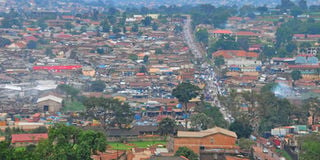Government admits failure on middle income dream

Kisenyi slum in Kampala. The National planning Authority says middle income status cannot be attained in 2020 because of serious inconsistencies in the implementation of key government projects. FILE PHOTO
What you need to know:
- In a no-holds-barred letter, Dr Kisamba says given the projected economic growth of 5.5 per cent in the current financial year contrary to the 15 per cent envisaged in the National Development Plan (NDP), “it’s very unlikely” that Uganda will achieve the lower middle- income status.
- In a detailed analysis of the 2017/18 budget and NDP II, he noted serious inconsistencies in the implementation of key government projects and revealed that with less than three months to the end of this financial year, the budget performance across sectors of the economy, is “unsatisfactory”.
- The budget macroeconomic targets, according to NPA analysis, significantly differ from NDPII targets and slow budget release performance, and absorption made matters worse.
- Dr Ezra Suruma, an economist and former Finance minister, agrees with NPA narrative on the economy, particularly that the budget is not aligned to the development agenda and that the country cannot achieve the lower middle-income status without fixing the aforementioned challenges.
- At this pace of implementation, Dr Kisamba said, achieving NDPII aspirations is unlikely. For example while the Agriculture Cluster Development Project was planned to start in 2013, four years later, it is still at inception stage.
The National Planning Authority (NPA) chairman, Dr Wilberforce Kisamba Mugerwa, has said Uganda will not achieve the coveted middle income status by 2020 because of the declining economy.
In a no-holds-barred letter, Dr Kisamba says given the projected economic growth of 5.5 per cent in the current financial year contrary to the 15 per cent envisaged in the National Development Plan (NDP), “it’s very unlikely” that Uganda will achieve the lower middle- income status.
“The low economic growth performance for the last three years of NDPII implementation implies that the country may not be able to achieve the lower middle income status by 2020,” reads in part Mr Kisamba’s March 27 letter to Finance minister Matia Kasaija and Speaker of Parliament Rebecca Kadaga.
He noted, for instance, that the economy grew at only 4.8 per cent and 4.0 per cent in 2015/16 and 2016/17 respectively, and is projected to grow at 5.5 per cent in this financial year ending June against the NDP target of 5.8 per cent, 5.9 per cent and 6.6 per cent for the same years.
For Uganda to attain the lower middle-income status in the remaining two years, NPA officials say the economy has to grow by more than 15 per cent annually.
Challenges
However, the latest data from International Monetary Fund (IMF), shows that the only country that has ever attained the double-digit economic growth is Nauru, a tiny island country in Micronesia, northeast of Australia. Other fastest growing economies in the world such as Ethiopia, Turkmenistan, Qatar, China and Uzbekistan do not have double-digit economic growth.
With the 2020 middle income dream in balance, Dr Kisamba, a former Finance minister, suggested that “the country should remain focused on the middle-income agenda by pragmatically and prudently implementing the prioritised interventions in the Vision 2040 and its attendant plans.”
In a detailed analysis of the 2017/18 budget and NDP II, he noted serious inconsistencies in the implementation of key government projects and revealed that with less than three months to the end of this financial year, the budget performance across sectors of the economy, is “unsatisfactory”.
Dr Kisamba attributed the poor budget compliance to failure to translate the sector strategic plans into budget actions.
He noted that under the National Strategic Direction, the budget fell from 74.2 per cent to 59.3 per cent while performance of sectors, ministries, departments and agencies is also ‘unsatisfactory’ with a high-pitched decline from 60.1 per cent to 53.2 per cent.
The longstanding problem of understaffing notwithstanding, the NPA analysis noted some improvement in local governments puts performance in the districts at 62.2 per cent in the current financial year compared to 51.8 per cent in 2016/17. The NPA says the “moderately satisfactory” performance of the districts was due to approved development plans and good budget releases by the Finance ministry.
Although NPA notes significant improvement in development plans, the challenge is in translating them into budget actions that contribute to NDPII macroeconomic targets. For instance, out of 16 sectors, 15 have development plans approved and aligned to the national development agenda. Of 135 ministries, departments and agencies, 89 have approved plans aligned to NDPII; 18 have existing plans but not aligned to NDPII timeframe. Eighteen have draft plans and 10 agencies have no strategic plan at all.
The budget macroeconomic targets, according to NPA analysis, significantly differ from NDPII targets and slow budget release performance, and absorption made matters worse. The NPA analysis, hailed by MPs across the political spectrum, particularly the members on committees of Budget and National Economy, also highlights the disconnect between planning and budgeting.
Dr Kisamba noted, for instance, that the budget macroeconomic indicators [the economic statistics which are released periodically by government agencies] differ significantly from NDPII. Instead, the budget indicators seem more closely aligned to the IMF policies.
These indicators provide insight into the economic performance of a particular country or region, and therefore can have a significant impact on the Forex market.
Mr Eddie Kwizera, a senior consultant at Strategic Management Services, blames the inconsistences on an ambitious national development plan that has failed to respond to the budget realities.
“The problem we have in Uganda is we made ambitious development plans. The plans we are struggling to implement were not guided by the revenues. The government only budgets for the available revenue without regard to the needs of these documents….This is the dilemma we are in and this is why we cannot achieve the lower middle income status the President promised the country ,” Mr Kwizera says.
He also points out what he calls, “political issues” which he says at times eat into the budget priorities to fulfill what other authorities have tagged “off-budget expenditures.”
Although Mr Kasaija has always painted a rosy picture of the economy, critics have likened him to a man winking in the dark. They say the Finance minister has an exaggerated view of the economy yet household incomes continue to stagnate, and millions of Ugandans still cannot find jobs while others are stuck in abject poverty.
Dr Ezra Suruma, an economist and former Finance minister, agrees with NPA narrative on the economy, particularly that the budget is not aligned to the development agenda and that the country cannot achieve the lower middle-income status without fixing the aforementioned challenges.
Masaka Municipality MP Mathias Mpuuga, a member of Parliament’s Public Accounts Committee, says government must set priorities in the budget and stick to the agreed plans.
“The reasons for deviating from the NDPII are related to sheer greed and political expediency. The budget is no longer a tool for social economic transformation, but a tool for political manipulation and official grand corruption to support patronage,” Mr Mpuuga says.
He adds that the NDPII is a well-meaning document which has been reduced to a “mere paper tiger”.
However, the legislator notes the only thing government has executed in the NDPII is infrastructure development.
NRM Deputy Secretary General Richard Todwong agrees with NPA findings. He accuses leaders of not reading Vision 2040 that has the NDPII and the ruling party’s manifestos, which he says should guide the budgeting process and be reflected in the ministerial policy statements and district development plans.
“Leaders should take these documents seriously because they should inform the budgeting process,” Mr Todwong says.
Mr Julius Mukunda, the executive director of the Civil Society Budget Advocacy Group (CSBAG), too dismisses the belief that Uganda will achieve the middle income status by 2020.
“Our budget is not sustainable and adherence to the NDPII is below average, so no middle class will be achieved. The Auditor General said 15 sectors don’t have plans, so what are they implementing… it’s a dilemma,” Mr Mukunda says.
The 2017/18 budget failed the compliance test at all levels. Dr Kisamba noted that on the macroeconomic strand, the budget is less compliant with only 41.9 percent compared to last financial year’s 48.1 percent and has been classified as disappointing. Specifically, the budget is 54.2 per cent compliant compared to 58.8 percent in 2016/17.
“The progress of implementation of NDPII core projects is unsatisfactory and presents high-risk for attaining the planned NDPII outcomes. Most of the projects are performing below NDPII schedule while others have completely failed to kick off,” Dr Kisamba stated in his letter.
Key concerns
Of the 39 core projects envisaged in the first three years of NDPII, only two are being implemented on project schedule, representing 5.2 per cent, while 7 projects (35.9 per cent) are being implemented but below schedule and 17.9 per cent are still under preparatory stage. The remaining 28.2 per cent have not yet started, two years to the deadline for lower middle income status.
At this pace of implementation, Dr Kisamba said, achieving NDPII aspirations is unlikely. For example while the Agriculture Cluster Development Project was planned to start in 2013, four years later, it is still at inception stage. Other strategic projects such as enhancing national food security through increased rice production in eastern Uganda and the Regional Pastoral Livelihood Improvement Project have delayed without explanation
Weighing in on the skyrocketing land compensation Bill, Dr Kisamba’s report says this expenditure is crowding out the impact of infrastructure projects and slowing progress of the implementation of NDPII core projects that are critical for development. Land compensation alone accounts for about Shs1 trillion for road projects. This amount is enough to tarmac about 300kms of roads.
In his report, Dr Kisamba cited the cost of land compensation for Entebbe-Kampala Expressway as more than Shs308 billion, which is enough to make about 100km of paved road. Dr Kisamba says this is not sustainable and has increased the infrastructure costs and reduced value for money on public investments.
KEY CHALLENGES
Performance. For Uganda to attain the lower middle-income status in the remaining two years, NPA officials say the economy has to grow by more than 15 per cent annually.,
Contradiction. However, the economy grew at only 4.8 per cent and 4.0 per cent in 2015/16 and 2016/17 respectively, and is projected to grow at 5.5 per cent in this financial year ending June against the NDP target of 5.8 per cent, 5.9 per cent and 6.6 per cent for the same years.
Suggestions. NPA says the country should remain focused on the middle-income agenda by pragmatically and prudently implementing the prioritised interventions in the Vision 2040 and its attendant plans.
Additional reporting by Misairi Kahungu Thembo




